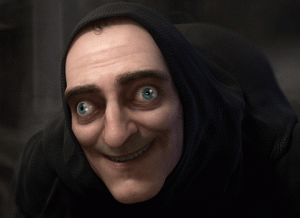 When I pick up my toddler, Sasha, from day care, there are certain rituals I go through. A brief chat with the teachers, pleasantries exchanged with other parents, and then, just before we go out the door, I require Sasha to say good-bye to everyone. This can be as little as a wave and a “Bye-bye!” or as much as a hug and kiss and a “See you tomorrow!” Usually, Sasha does this enthusiastically.
When I pick up my toddler, Sasha, from day care, there are certain rituals I go through. A brief chat with the teachers, pleasantries exchanged with other parents, and then, just before we go out the door, I require Sasha to say good-bye to everyone. This can be as little as a wave and a “Bye-bye!” or as much as a hug and kiss and a “See you tomorrow!” Usually, Sasha does this enthusiastically.
There’s one little complication, though: She has trouble making eye contact with her teachers and friends as she says good-bye, and we usually have to hold her head facing these people.
This is so, so, so, so minor, but it makes me nervous because, you know, Google, which brings up all kinds of pages discussing autism and sensory processing disorders and things that tend to freak me out, even though, by any other measure, Sasha is definitely not on the autism spectrum. It does, however, remind me of my own problems with eye contact, which are probably noticed by no one except me. Basically, I find it hard to make eye contact and either try to talk across to someone, or stand far back enough that my lack of direct eye contact isn’t noticeable. If pressed, I’ll do what I can, but it never feels right or comfortable to look into someone’s eyes, and my vision usually drifts to their mouth instead. Or their boobs, if they’ve got them.
(Am I the only one with this problem? Let’s not ask Google.)
Anyway, this is really me just worrying about nothing at all. One of those Google hits was this, in which Patricia Henderson Shimm, author of Parenting Your Toddler: The Expert’s Guide To The Tough And Tender Years, reassures overly concerned people like me that this is normal:
Before the age of 3, most toddlers don’t yet grasp the importance of looking people in the eye when speaking to them. In fact, looking down or away is how they attempt to take control of a situation. When you’re explaining to your child that he shouldn’t jump on the bed, for example, he may look at a wall to avoid becoming overwhelmed with feelings of guilt. Or if it’s his birthday and he’s receiving presents, your child may not be able to look at Grandpa because he’s too excited. One way to draw your child out is to use a puppet to talk to him. Get his attention by placing the puppet within his line of vision. Use it to help him focus on you, then drop the puppet and catch his gaze.
Which is great! Unfortunately, she says nothing about 36-year-olds.

Hey, I have the same problem, and I’m 36 too! I was a “shy” kid and nobody really forced me to learn the art of talking to people correctly. It was only when I became a manager of finance at a big company, hanging around with VPs and other high status people that I saw how easy it was to talk to others and how much better things went when you look them in they eye and did other personable things.
I’m a lot better now simply through practice. That’s all you need. Force yourself to look a bunch of strangers in the eye. After the earth closes up, the dragons have left and the boils healed you’ll realize that they were never there in the first place.
Oh, and I’m going to be trying my first open-mike comedy set in the next month.
Practice—sounds like a good idea. Now can someone please arrange for Zooey Deschanel to be my practice partner? Those are some eyes I wouldn’t mind staring into…
My husband – definitely not autistic, but he’s an engineer and a Caltech grad, if you know what I mean – has a really hard time making eye contact with people unless he knows them well. I doubt most other people even notice it, but I notice him averting his eyes and it drives me nuts – ah, marriage.
You’re lucky, though – I’ve known toddlers who were really into staring at you way over-long, and that is so creepy and so much worse.
I have a horrible time making eye contact–years of shyness I guess, but who knows exactly why.
But that spot just the left of someone’s head? I can stare that down like nobody’s business.
We’ll just have to have the kid learn that stuff from his (much more outgoing) dad.
Well, I guess it’s good to know that many of us have yet to master the skills they’re teaching my toddler. Progress!
I used to have a problem with eye contact because I thought about it too much. Which eye should I look into? Because you can’t really look at both at once. Somebody smart told me to just look at the interlocutor’s nose. Works like a charm.